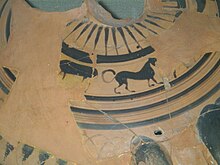Iaitas
Iaitas (Latin: Ietas , Mittellat: Iato ) was the Greek name of an ancient city in northwestern Sicily . It was on a high plateau of Monte Iato in an area that today belongs to the communities of San Giuseppe Jato and San Cipirello . The city was destroyed by Friedrich II in 1246 , and the area has been uninhabited since then.
history
The beginnings of settlement go back to prehistoric times, into the early 1st millennium BC. BC, back. Towards the end of the 7th century BC The first contact with Greek culture can be demonstrated on the basis of the finds. Whether the inhabitants of that time are to be assigned to the Elymers or the Sikanas cannot be determined on the basis of the archaeological finds. The city was under the Punic sphere of influence of Sicily, but cultural achievements of the Greeks were also adopted.
Around 300 BC The hilltop settlement is largely rebuilt based on the model of a Greek city, which can be seen archaeologically in particular on the basis of the public buildings such as the fortification system, the agora or the theater , but also on the basis of spacious residential buildings based on the Greek model. In Roman times the city received the status of a municipium , but then lost more and more importance and seems to have been given up in late antiquity , or to have limited itself to areas of the settlement area that were still unexplored.
In the later 10th century AD, towards the end of the Fatimid rule in Sicily , the city seems to experience a second heyday. According to Malaterra , the city refused allegiance and tribute to the Norman Roger I , whereby - according to the prince's chronicler - the city, now called Iato, relied on its large population and the good fortification of the place. From 1182 the city is subordinated to the newly founded Archdiocese of Monreale and during the late Norman and Staufer period it became the actual center of Muslim resistance in Sicily. This finally sealed the destruction of the city in 1246 AD by the troops of Frederick II , who deported the surviving residents to Lucera and placed a settlement ban on Monte Iato.
exploration
Since 1971, the high plateau of Monte Iato has been excavated by the Archaeological Institute of the University of Zurich in annual campaigns. The results are published in annual preliminary reports in the magazines Antike Kunst ( German ) and Sicilia Archeologica ( Italian ), and further evaluations are published in the monographic series "Studia Ietina".
sightseeing
As an archaeological park, Monte Iato can be visited free of charge during the day. Access is via a road from the southeast of the mountain. In the new associated archaeological museum opened in 2010, which has replaced the previous antiquarium in San Cipirello , finds from Monte Iato from archaic times to the Middle Ages can be viewed.
Other finds from Monte Iato are in the local museum of Partinico and in the Archaeological Museum Antonino Salinas in Palermo .
Individual evidence
- ↑ http://www.archaeologie.uzh.ch/de/klarch/research/GrabungMonteIato.html
- ↑ https://www.uibk.ac.at/projects/monte-iato/index.html.de
- ↑ Ibid.
- ^ Daniel Käch: The oil lamps from Monte Iato. Excavation campaigns 1971-1992 , Studia Ietina IX , Lausanne 2006, p. 229.
- ↑ Malaterra XX, 20.
Bibliography
- Hans Peter Isler : Monte Iato. Guida archeologica . Sellerio editore, Palermo 2000, ISBN 88-389-1681-0
- Hans Peter Isler (Ed.): Studia Ietina . Vol. I-IX. (Series of monographs on the excavations on Monte Iato)
Web links
- Information about the excavations on the website of the Archaeological Institute of the University of Zurich
- Information about the Innsbruck research on the project page of the Monte Iato project of the University of Innsbruck
- L'Area Archeologica on the website of the Municipality of San Cipirello
- Guida breve - Monte Iato a cura della Soprintendenza Beni culturali ed ambientali di Palermo - Servizio per i beni archeologici.
Coordinates: 37 ° 58 ′ 0 ″ N , 13 ° 12 ′ 0 ″ E

